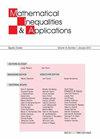二维类walsh系统的锥型受限可和性的迁移方法
IF 0.7
4区 数学
Q2 MATHEMATICS
引用次数: 0
摘要
。本文研究了一类d维均值的极大算子的有界性,其条件是指标集在锥型集合L内。对求和核np 1,…在p b> p 0时,我们证明了锥型受限极大算子T γ CLR从Hardy空间H γ p有界到Lebesgue空间L p。在端点p 0上,假设在一维核上的一些自然条件,我们证明了极大算子T γ CLR从Hardy空间H γ p 0到Lebesgue空间L p 0没有界。本文章由计算机程序翻译,如有差异,请以英文原文为准。
Transference method for cone-like restricted summability of the two-dimensional Walsh-like systems
. In the present paper we investigate the boundedness of the maximal operator of some d -dimensional means, provided that the set of the indeces is inside a cone-like set L . Applying some assumptions on the summation kernels P n 1 ,..., n d we state that the cone-like restricted maximal operator T γ CLR is bounded from the Hardy space H γ p to the Lebesgue space L p for p > p 0 . In the end point p 0 assuming some natural conditions on one-dimensional kernels we show that the maximal operator T γ CLR is not bounded from the Hardy space H γ p 0 to the Lebesgue space L p 0 .
求助全文
通过发布文献求助,成功后即可免费获取论文全文。
去求助
来源期刊
CiteScore
2.30
自引率
10.00%
发文量
59
审稿时长
6-12 weeks
期刊介绍:
''Mathematical Inequalities & Applications'' (''MIA'') brings together original research papers in all areas of mathematics, provided they are concerned with inequalities or their role. From time to time ''MIA'' will publish invited survey articles. Short notes with interesting results or open problems will also be accepted. ''MIA'' is published quarterly, in January, April, July, and October.

 求助内容:
求助内容: 应助结果提醒方式:
应助结果提醒方式:


